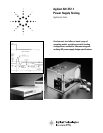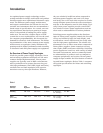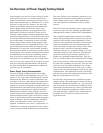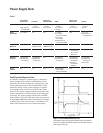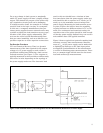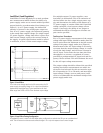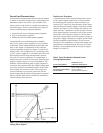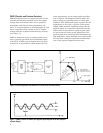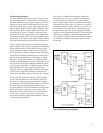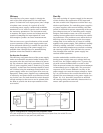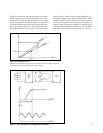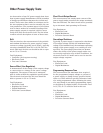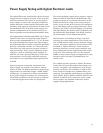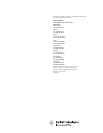
7
Current Limit Characterization
Current limit measurements demonstrate the degree
to which a constant voltage power supply limits its
maximum output current to a preset value. This
preset value can be fixed or variable throughout a
specified range. There are basically three types of
current limiting design implementations:
1. Conventional current limiting power supplies
2. CV/CC mode power supplies
3. Foldback current limiting power supplies
Conventional current limiting power supplies
and CV/CC mode power supplies are very similar
in function. These implementations generally vary
only in the degree of regulation in the constant
current operating region (see Figure 5) and in the
ability of the user to adjust the CC operating point
(CV/CC power supplies). A rounded crossover knee
and sloping current limit characteristic denotes
less precise current regulation. In comparison, a
sharp knee and vertical current limit characteristic
denote a higher degree of current regulation. The
foldback current limiting power supply employs a
technique that enables both the output voltage and
current to decrease simultaneously for load resist-
ances below the crossover value. The purpose of
current limiting is to provide protection for the
power supply and the device being powered (assum-
ing the current limit value is below the maximum
current rating of the device).
Test Overview/ Procedures
A measurement of the output voltage and current
of the power supply under test is required while
decrementing the electronic load resistance (or
current in CC mode) by steps from an initial value
that produces the power supply’s full rated voltage
output (see Figure 6). The voltage will remain con-
stant until the compliance current (output current
of the power supply) increases to the preset current
limit value. The crossover region or current limit
has been reached when the rated output voltage of
the power supply changes by a degree greater than
the load regulation specification. At the current
limit knee, the compliance current and output volt-
age behavior is determined by the type of current
limiting circuit implemented in the power supply
design (see Table 3).
Table 3. Typical Test Results of Standard Current
Limiting Implementations
I Compliance (or I
out
)
Current Limiting Method at Minimum Load Resistance
CV/CC Remain constant (CC mode)
Conventional Current Limiting Typically ≤(105%) I
max
Current Foldback Typically foldback is ≤(50%) I
max
Figure 5. Typical Operating Characteristics of Three Types of Current
Limiting Power Supplies



